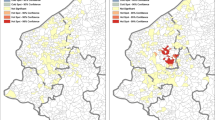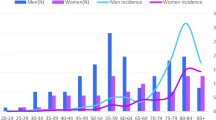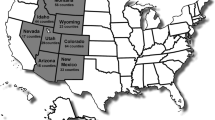Abstract
In Latin America, gastric cancer is a leading cancer, and countries in the region have some of the highest mortality rates worldwide, including Chile, Costa Rica, and Colombia. Geographic variation in mortality rates is observed both between neighboring countries and within nations. We discuss epidemiological observations suggesting an association between altitude and gastric cancer risk in Latin America. In the Americas, the burden of gastric cancer mortality is concentrated in the mountainous areas along the Pacific rim, following the geography of the Andes sierra, from Venezuela to Chile, and the Sierra Madre and Cordillera de Centroamérica, from southern Mexico to Costa Rica. Altitude is probably a surrogate for host genetic, bacterial, dietary, and environmental factors that may cluster in the mountainous regions. For example, H. pylori strains from patients of the Andean Nariño region of Colombia display European ancestral haplotypes, whereas strains from the Pacific coast are predominantly of African origin. The observation of higher gastric cancer rates in the mountainous areas is not universal: the association is absent in Chile, where risk is more strongly associated with the age of H. pylori acquisition and socio-economic determinants. The dramatic global and regional variations in gastric cancer incidence and mortality rates offer the opportunity for scientific discovery and focused prevention programs.






Similar content being viewed by others
References
Ferlay J, Shin HR, Bray F, Mathers C, DM Parkin (2010) Globocan 2008 v1.2, Cancer incidence and mortality worldwide: IARC CancerBase No. 10. International Agency for Research on Cancer, Lyon, France http://globocan.iarc.fr
Ferlay J, Shin HR, Bray F, Forman D, Mathers C et al (2010) Estimates of worldwide burden of cancer in 2008: GLOBOCAN 2008. Int J Cancer 127:2893–2917
Murray CJ, Lopez AD (1997) Alternative projections of mortality and disability by cause 1990–2020: global burden of disease study. Lancet 349:1498–1504
de Martel C, Ferlay J, Franceschi S, Vignat J, Bray F et al (2012) Global burden of cancers attributable to infections in 2008: a review and synthetic analysis. Lancet Oncol 13:607–615
Farinati F, Cardin R, Cassaro M, Bortolami M, Nitti D et al (2008) Helicobacter pylori, inflammation, oxidative damage and gastric cancer: a morphological, biological and molecular pathway. Eur J Cancer Prev 17:195–200
Ushijima T, Hattori N (2012) Molecular pathways: involvement of H. pylori-triggered inflammation in the formation of an epigenetic field defect, and its usefulness as cancer risk and exposure markers. Clin Cancer Res 18:923–929
Gobert AP, Asim M, Piazuelo MB, Verriere T, Scull BP et al (2011) Disruption of nitric oxide signaling by H. pylori results in enhanced inflammation by inhibition of heme oxygenase-1. J Immunol 187:5370–5379
Castro Lde P, Coelho LG (1998) Helicobacter pylori in South America. Can J Gastroenterol 12:509–512
Ferreccio C, Rollan A, Harris PR, Serrano C, Gederlini A et al (2007) Gastric cancer is related to early H. pylori infection in a high-prevalence country. Cancer Epidemiol Biomarkers Prev 16:662–667
(2011) Perfil Epidemiologico de los tumores malignos en Mexico. Mexico, D.F., Mexico: SINAIS/SINAVE/DGE/SALUD
Piñeros M, Pardo C, Gamboa O (2010) Hernandez G (2010) Atlas de mortalidad por cancer en Colombia, 2nd edn. Instituto Geogragico Agustin Codazzi, Bogota
Munoz N, Kato I, Peraza S, Lopez G, Carrillo E et al (1996) Prevalence of precancerous lesions of the stomach in Venezuela. Cancer Epidemiol Biomarkers Prev 5:41–46
(2009) Centro de Control de Cancer Gastrointestinal Luis E Anderson 1980–2000. v.34 n.9 ed. Caracas, Venezuela: INCI
(2009) Analysis of gastric cancer in Leon, Nicaragua 2006–2008. UNAN, Leon, HEODRA: Nicaragua Ministry of Health
(2006) Incidencia Cancer 1995–2005. In: Registry CRNT, editor. San Jose, Costa Rica: http://www.ministeriodesalud.go.cr/index.php/component/ content/article/43 pagina-inicio-ms/136-incidencias-cancer-2005-ms
Morgan DR, Dominguez RL, Keku TO, et al. (2007) Gastric cancer and the synergy of selenium, host cytokine risk genotypes, and H. pylori infection in Central America. Gastroenterology 132(4, S2):A29
Correa P, Cuello C, Duque E et al (1976) Gastric cancer in Colombia. III. Natural history of precursor lesions. J Natl Cancer Inst 57:1027–1035
Recavarren-Arce S, Ramirez-Ramos A, Gilman RH, Chinga-Alayo E, Watanabe-Yamamoto J et al (2005) Severe gastritis in the Peruvian Andes. Histopathology 46:374–379
Morgan DR, Dominguez RL, Keku TO et al (2006) Gastric cancer and the high combination prevalence of host cytokine genotypes and H. pylori in Honduras. Clin Gastroenterol Hep 4:1103–1111
Dominguez R, Morgan DR (2001) High incidence of gastric cancer in western Honduras. Fourth Internacional Gastric Cancer Congress. IGCA, New York, NY, p A322
Wilfley L, Dominguez R, Martin C, Heidt P, Morgan DR (2007) The “Altitude Enigma” in gastric cancer inn Central America. In: Gastroenterology 132(4, S2):A345
Rothammer F, Dillehay TD (2009) The late pleistocene colonization ofnSouth America: an interdisciplinary perspective. Ann Hum Genet 73:540–549
Andia ME, Hsing AW, Andreotti G, Ferreccio C (2008) Geographic variation of gallbladder cancer mortality and risk factors in Chile: a population-based ecologic study. Int J Cancer 123:1411–1416
Persson C, Canedo P, Machado JC, El-Omar EM, Forman D (2011) Polymorphisms in inflammatory response genes and their association with gastric cancer: a HuGE systematic review and meta-analyses. Am J Epidemiol 173:259–270
Gianfagna F, De Feo E, van Duijn CM, Ricciardi G, Boccia S (2008) A systematic review of meta-analyses on gene polymorphisms and gastric cancer risk. Curr Genomics 9:361–374
Figueiredo C, Machado JC, Pharoah P, Seruca R, Sousa S et al (2002) Helicobacter pylori and interleukin 1 genotyping: an opportunity to identify high-risk individuals for gastric carcinoma. J Natl Cancer Inst 94:1680–1687
de Sablet T, Piazuelo MB, Shaffer CL, Schneider BG, Asim M et al (2011) Phylogeographic origin of H. pylori is a determinant of gastric cancer risk. Gut 60:1189–1195
Bravo LE, van Doom LJ, Realpe JL, Correa P (2002) Virulence-associated genotypes of H. pylori: do they explain the African enigma? Am J Gastroenterol 97:2839–2842
Fox JG, Wang TC, Nagler-Anderson C (2001) The African enigma: the parasite’s perspective. Gut 49:156–157
Segal I, Ally R, Mitchell H (2001) Gastric cancer in sub-Saharan Africa. Eur J Cancer Prev 10:479–482
Piazuelo MB, Camargo MC, Mera RM, Delgado AG, Peek RM Jr et al (2008) Eosinophils and mast cells in chronic gastritis: possible implications in carcinogenesis. Hum Pathol 39:1360–1369
Whary MT, Sundina N, Bravo LE, Correa P, Quinones F et al (2005) Intestinal helminthiasis in Colombian children promotes a Th2 response to H. pylori: possible implications for gastric carcinogenesis. Cancer Epidemiol Biomarkers Prev 14:1464–1469
Ryan JL, Morgan DR, Dominguez RL, Thorne LB, Elmore S et al (2009) High levels of epstein-barr virus DNA in latently infected gastric adenocarcinoma. Lab Invest 89:80–90
Kabuto M, Imai H, Yonezawa C, Neriishi K, Akiba S et al (1994) Prediagnostic serum selenium and zinc levels and subsequent risk of lung and stomach cancer in Japan. Cancer Epidemiol Biomarkers Prev 3:465–469
Camargo MC, Burk RF, Bravo LE, Piazuelo MB, Hill KE et al (2008) Plasma selenium measurements in subjects from areas with contrasting gastric cancer risks in Colombia. Arch Med Res 39:443–451
La Vecchia C, Franceschi S (2000) Nutrition and gastric cancer. Can J Gastroenterol 14 Suppl D: 51D–54D
Mora D (2003) Evolucion de algunos aspectos epidemiologicos y ecologicos del cancer gastrico en Costa Rica. Rev Costarric Salud Publica 12(no. 21): 7–17
Camargo MC, Yepez MC, Ceron C, Guerrero N, Bravo LE et al (2004) Age at acquisition of H. pylori infection: comparison of two areas with contrasting risk of gastric cancer. Helicobacter 9:262–270
Liu C, Russell RM (2008) Nutrition and gastric cancer risk: an update. Nutr Rev 66:237–249
Acknowledgments
JT is a recipient of an exclusivity scholarship from Fundación IMSS, México. Portions of this study were grant supported in part by NIH CA1255884 (DRM).
Author information
Authors and Affiliations
Corresponding authors
Additional information
Javier Torres and Douglas Morgan have contributed equally to this work.
Rights and permissions
About this article
Cite this article
Torres, J., Correa, P., Ferreccio, C. et al. Gastric cancer incidence and mortality is associated with altitude in the mountainous regions of Pacific Latin America. Cancer Causes Control 24, 249–256 (2013). https://doi.org/10.1007/s10552-012-0114-8
Received:
Accepted:
Published:
Issue Date:
DOI: https://doi.org/10.1007/s10552-012-0114-8




